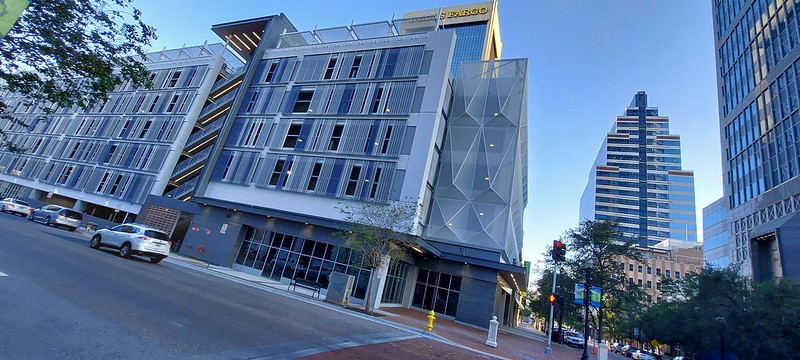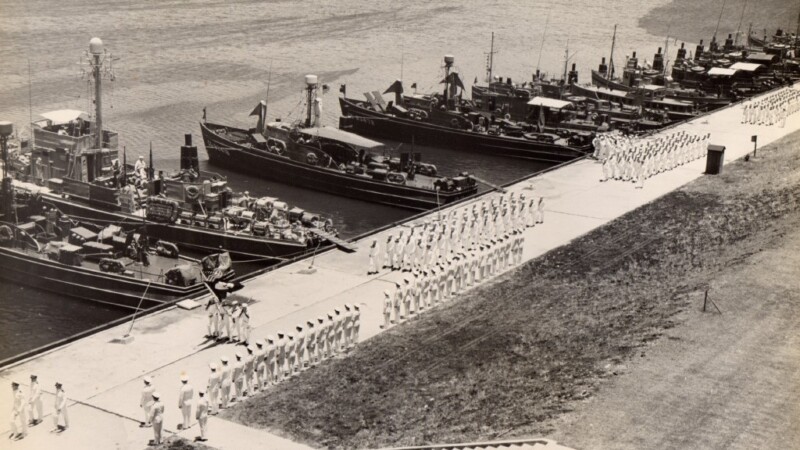
A new mayor and City Council members take office in July, and revitalizing Downtown Jacksonville will continue to be a top priority for the city government. Here are four proven, relatively simple, common-sense suggestions to spark revival without relying on huge budgets and massive new developments.
1. Embrace the “Three C’s” of urban revitalization

First up, any project or plan for Downtown should take advantage of a tried-and-true formula: the “Three C’s“, or the clustering of complementing uses within a compact setting. We at The Jaxson have long advocated for the Three C’s, a principle that has brought vibrancy to big-city downtowns and small-town main streets alike for thousands of years. The idea is simple: It doesn’t take big, expensive silver bullet projects or the span of generations to bring life to urban streets, but rather just a bit of coordination to concentrate amenities within easy walking distance of one another.
Here’s how it works: First is clustering. Residents, businesses and amenities benefit from being in close proximity to one another, feeding off each other’s foot traffic and creating a draw bigger than any individual component could do on its own. But clustering is only as effective as the individual uses that are clustered, which is where the second C, complementing uses, comes in. The uses need to work together for clustering to work, and in terms of an urban neighborhood, this means uses that encourage walkable, street-level activity. The final C, the compact setting, means that clustering should happen in a small enough area for all its parts to reap the benefits. In an urban area that means walkability. Studies suggest that most people will comfortably walk about a quarter mile from one destination to another. So ideally, clustering should occur within about a ¼-mile radius.
Jacksonville has had a hard time implementing the Three C’s in Downtown, and its vibrancy has suffered as a result. Fortunately, the Three C’s are easy once a city embraces them, and the benefits come quickly. As such, the city of Jacksonville should make the Three C’s core to its Downtown plans and development projects.
2. Prioritize streets to spark development

So how can we identify the best areas for clustering? Jacksonville needs to prioritize specific streets and corridors where some elements are already in place — getting ahead of the game by building on what we already have. A good place to start would be defining our primary and secondary streets. Primary streets are high-traffic, high visibility commercial corridors, whereas secondary streets are those that see lower volumes of traffic and can support businesses on the primary street with delivery access, parking and other services. Defining our primary streets and encouraging clustering there would go a long way toward improving Downtown’s street-level activity quickly.
Contrary to popular belief, streets with higher traffic counts can be excellent for creating a vibrant, walkable environment. Many cities, and some of Jacksonville’s most popular neighborhoods, testify to this fact. The key is ensuring the streets are designed with that goal in mind. As such, once primary retail streets are identified, it’s imperative that the city concentrate on redesigning them to encourage additional business growth. Jacksonville had success in this regard in transforming Laura Street into a walkable corridor, and the city has long recognized the need to convert key streets back into two-way corridors. Unfortunately, plans to make this happen have been left on the backburner for many years as the city focused on other things.
Fortunately, once these projects do start, they can be executed pretty quickly. Lakeland, for instance, took only a month and $115,000 to streetscape a block of Main Street back in 2021, and the results show how small investments that take advantage of what you already have can create a great placemaking impact practically overnight. As such, it’s all the more important for city leaders to push these plans forward and make these crucial investments now for core corridors like State and Union streets, Park Street in Brooklyn, and Broad Street in LaVilla.
3. Activate ground-floor retail

Buildings that interact with the pedestrian at street level, inside and out, are a key ingredient for any retail-friendly downtown. Active ground floor uses create valuable experiences along a street for both pedestrians and motorists. A row of shops along a street is generally more interesting, comfortable and engaging to walk by than a solid wall or surface parking. Sidewalk activity also serves as a tool to reduce vehicular speeds through the core.
At the very minimum, street-level spaces should be engaging visually, allowing passers-by to enjoy the activity and aesthetics of the indoor space. This active interaction should take place year-round and unite both sides of the street on weekdays, nights and weekends.
Despite the grim view many have of Downtown’s retail scene, they may be surprised to learn that there are a number of businesses already in operation Downtown that can not be seen from the street.
For example, Crazy Beans Coffee offers breakfast and lunch along with a selection of ethically sourced coffee and desserts like pastries. Unfortunately, unless you’re a JTA customer, employee or visitor, you’d never know that there was a local, family-owned coffeehouse at the Jacksonville Regional Transportation Center in LaVilla. Thousands enter Downtown daily on West Forsyth Street from I-95, not knowing the coffeehouse exists because the tenant isn’t allowed to have outdoor seating or signage. Not only is this situation financially limiting for local business owners, it also serves as a major contributing factor to the empty feeling of Downtown’s streetscape.
A simple, low-cost solution to increasing Downtown’s vibrancy is to eliminate weird policies that hide the visibility of existing street-level businesses. Doing such is an affordable placemaking solution that will immediately enhance walkability, stimulate additional foot traffic, and create economic opportunity for businesses to thrive.
4. Craft a vision for city-owned properties

In addition to renovating streets for walkability and focusing on clustering, the city of Jacksonville owns a large number of properties across Downtown that sit underused. To help kick revitalization into high gear, city leaders should craft a vision for them and how they can play into redevelopment of surrounding properties.
For many of these, the solution is simple: the city should just sell them. That is as simple as putting out Requests for Proposals (RFPs) and letting private owners present financially viable infill and adaptive-reuse projects that meet the vision and criteria of the RFP.
In other cases, the city should develop a long-term vision for the properties that show the community’s intention for them in years to come. If Downtown Jacksonville is going to have a new convention center, the master plan should specify the site, how it will be funded and the timeline for its construction. If Amtrak and passenger rail is going to return to the Prime Osborn, the city should estimate when it will happen and how much it will cost. Doing this will allow property owners developing nearby blocks to coordinate their efforts and achieve a more cohesive outcome for Downtown as a whole.







